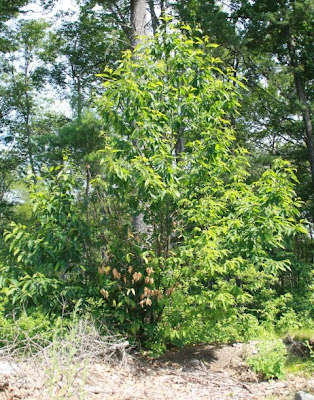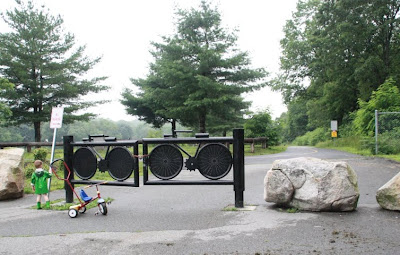
After having stumbled across a blooming American chestnut quite by accident, I was inspired to go hunting for more. I knew that the Nature Trail and Cranberry Bog at Patriot Place was full of chestnut regrowth, so it seemed like a logical place to search. While there were lots of chestnuts, tall ones even, along the wooded trail, they appeared to be too busy trying to reach sunlight to produce flowers. So I tried the parking lot.
And I lucked out - not one, but two flowering American chestnuts!

As a joke, I have been telling my friends how I am hunting for unicorns. So, I am giving my chestnut finds unicorn designation numbers. Let me introduce you to Unicorn 2 and Unicorn 3. (You've already met Unicorn 1.)

Unicorn 2 is a scraggly shrub, no more than 15 feet tall. She has some dead twigs, with withered leaves on some. Other dead twigs are bare.

The catkins are scattered unevenly about the tree. Most, from what I could see, only had male flowers.

More catkins. Click to see the image enlarged. I'm not seeing any female flowers here.

This one has female flowers, though.

These three female flowers were the only ones I was able to see, even when I zoomed in on my photos.

This tree is a shrubbery of suckers. But it isn't blocked by undergrowth, the ground is reasonably flat around it, and it would be easy to get a ladder here.

The main trunk measured in at 4 inches in diameter, at approximately 4.5 feet from the ground. But as you can see, there is blight damage.

Here are those dead twigs I had mentioned.

Lastly, here is the tree with each visible catkin-bearing branch marked. There are 30 marks. But I'm guessing that most of those clusters don't have female flowers.

Onward! Here is Unicorn 3, to the left of a light post. This one is maybe 25 or 30 feet tall. At first glance, it didn't appear to have flowers at all.

Male flowers.

More male flowers.

More male flowers. And overall, the catkins on this one are a lot smaller and . . . less enthusiastic?

Are these catkins just a bit more immature than the previous trees? I don't know.

The trunk is large, but I couldn't get to it to take a measurement. Nor could I see the ground. It may slope downward in there. And this looks like blight damage.

The thicket is too dense to casually walk up to this tree. I guestimate a diameter of 17 inches.

Higher up the tree.

I would mark flower clusters on this tree, but I can't even see them when I zoom into the photo. Click the image to enlarge.
Chris joked that I'm having such luck finding these unicorns because I have a virgin maiden along. Har har har.

Lastly, here is a map of the area, thanks to Google.
























